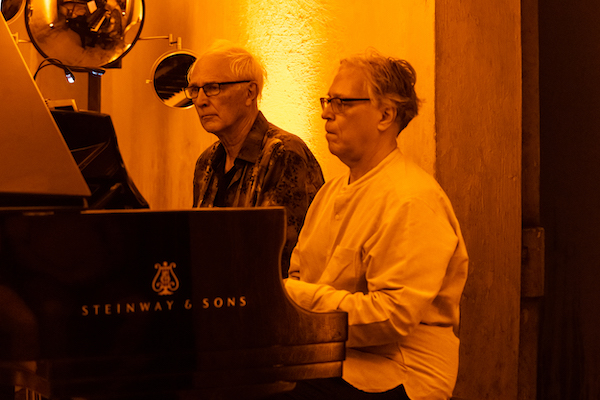Mahler’s Ninth, reduced yet not diminished for piano four hands

Mahler in a cemetery is almost too easy.
Yes, death is an element in almost all his music, but that doesn’t mean he’s a goth, and his music is about the whole experience of life.
In the same way, Death Of Classical is about the whole range of classical music—its concert settings are indeed evocative, but music in crypts brings those spaces to life.
Thursday night, that space was the catacombs at Green-Wood Cemetery, and the music was indeed Mahler, his valedictory Symphony No. 9, this time in a version for piano four-hands, played by Jed Distler and Jerome Kuderna. What one heard was more about life than anything else.
Arranging this symphony for the piano (the two played an uncredited Universal Editions score) means leaving behind Mahler’s genius as an orchestrator: no choked horns, shining flutes, dusky low winds. Subtler, but vital, Mahler used orchestration as psychological expression, and much of his string writing in Symphony No. 9 expresses the effort of struggling through life and with death.
The great pleasure of this performance was how the pair was committed to the struggle. This was a challenge to endurance, the two playing through the whole work when orchestral musicians at least get the chance to rest. Also impressive was that Kuderna was filling in at the last minute for Stewart Goodyear, who withdrew for the performance due to illness. Kuderna knew the work already and was available, and the only sign of possible lack of rehearsal were a couple occasions when both pianists reached for the same page turn.
Other than that, the musical communication and coordination was strong and sensitive. Distler was at the left, playing mostly the lower parts, Kuderna on the right; the arrangement had little overlapping of hands, though there were some tight squeezes. The two treated the myriad variations in tempo one would hear from an orchestra for the kind of clear-edged, highlighted articulation the piano can produce. This was intelligent artistry, accepting that this was a different version and making the most of it and the instrument.
The reduction made thematic details more prominent, and the pianists were clearly committed to revealing each phrase as clearly as possible, even in passages with dense, stormy polyphony. This didn’t always work—the strange bass clarinet solo in the first movement was lost in the monochromatic sound of the piano, but transitions were marvelously clear and smooth, with excellent sense of proportion.
And the transitions are deeply important in this work, which is both structurally through-composed and conceptually about the constant back and forth movement between light and dark, ruminatively mixing both joy and despair, peace and turmoil together. These sensations were both juxtaposed Thursday, and also felt simultaneously. That is the expressive genius of Mahler, and one felt Mahler at his poignant best in this performance.
Distler and Kuderna provided a superb view of the structure of the Ninth. The longer outer movements felt like sturdy bookends to the wild emotional swings between the two inner movements. The Ländler was bouncy and sunny, the Rondo-Burleske built up to the frenzy one hears from great orchestral performances. The beginning of that movement lagged a little in energy, the only hint that the musicians were taxed at all in the performance.
In fact, the concentration was strong throughout, and even inspired. There were times when Kuderna briefly sang the music he was playing out loud. One was not sure whether he was aware of that or not, but it was wonderful to hear the music effect him so. And it was intimate in a way that an orchestra can never achieve, whether live or through recording.
That was the highest pleasure of this performance, heard intensely in the end, where the music’s sense of acceptance came through, and even more there was a sense of glowing joy.
This performance repeats two times nightly, Friday and Saturday, starting at 6 p.m. deathofclassical.com

Posted Aug 06, 2022 at 10:12 am by Rob Cowan
Sounds mightily impressive!
Posted Aug 06, 2022 at 11:16 am by Virko Baley
Congratulations; I personally remember playing piano-4-hands Mahler’s 5th and 6th. What a pleasure. I wish I could have been there!!!
Posted Aug 08, 2022 at 2:31 am by Adrienne
Congrats on an amazing performance!